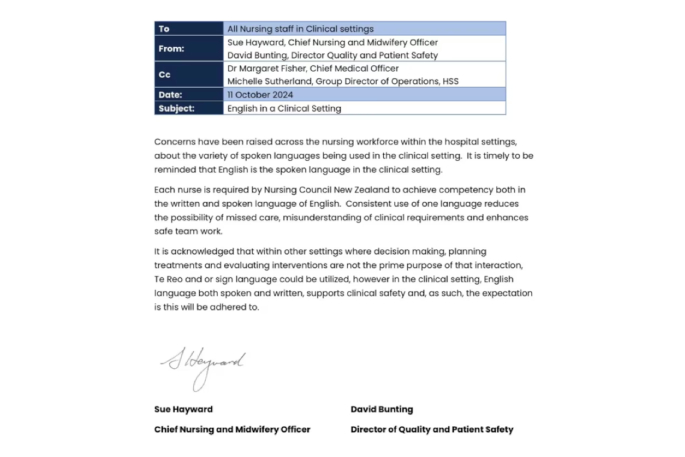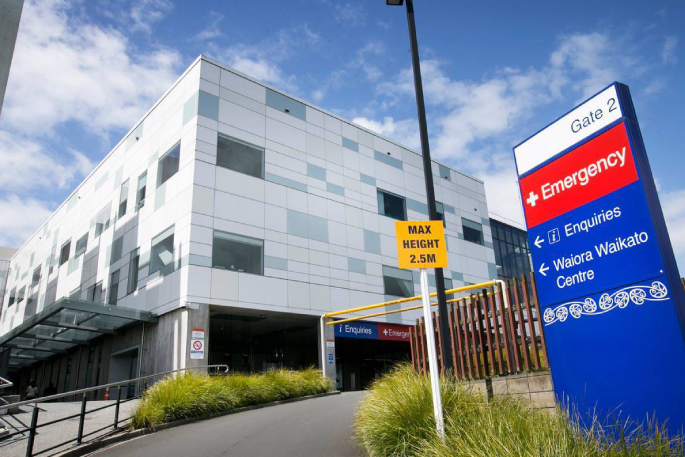Waikato public hospital has told nurses not to speak to patients in any language other than English.
A memo sent to all nursing staff last Friday, obtained by RNZ, said concerns had been raised about other languages being used, and that exclusive use of English in all clinical settings was safer for treating people.
A doctor who saw the memo said it was clearly aimed at Indian, Filipino and Pasifika nurses, who were healthcare “heroes” but were now being victimised.
The memo, which appears to be confined to Waikato district, comes after Te Whatu Ora employed thousands of extra nurses from Asia to plug workforce shortages, blowing out its budget by hundreds of millions of dollars.
It is also just days after the Herald reported that a patient at North Shore Hospital asked not to receive care from anyone of Asian ethnicity – a request that was initially granted by management, to the distress of staff.
The Waikato memo from the chief of nursing and midwifery, and the director of quality and patient safety, also took aim at the use of te reo in any clinical setting.
“Concerns have been raised across the nursing workforce within the hospital setting, about the variety of spoken languages being used in the clinical setting,” it said.
“It is timely to be reminded that English is the spoken language in the clinical setting.”
Each nurse had to be competent in spoken and written English.
“Consistent use of one language reduces the possibility of missed care, misunderstanding of clinical requirements and enhances safe teamwork.”
RNZ asked HNZ Te Whatu Ora for examples of missed care or misunderstood clinical requirements.
The memo continued, saying that in “other settings” – as long as decisions were not being made, or treatment planned or evaluated – “te reo and or sign language could be utilised”.
“However, in clinical settings, English language, both spoken and written, supports clinical safety and, as such, the expectation is this will be adhered to.”
The Waikato Hospital doctor who saw the memo called it a “quite concerning (frankly: sick) email”.
“We all know in between the lines that this is mostly directed against our most vulnerable employees in the workforce [Indian, Filipino and Pasifika nurses] who sometimes speak some words in their own language while working under extreme pressure to manage our overburdened wards.
“Instead of being recognised as heroes in our healthcare system, they have to deal with this piece of crap from some apparently useless TWO managers.
“Frankly disgusting and so [much for] Te Whatu Ora embracing multiculturalism.”
Hundreds, if not thousands, of international nurses have joined the workforce recently.
However, hundreds more attracted to New Zealand by overseas recruiters are without work, after spending $30,000-$50,000 to travel here, do competency assessments, sit exams and prove their English proficiency, to get a licence from the Nursing Council.
India and the Philippines have officially cautioned nurses against coming to New Zealand without a guaranteed job.
Te Whatu Ora Waikato group director of operations Michelle Sutherland said the memo was sent to nursing staff to “help reduce confusion” as speaking English in a clinical environment was standard practice and a Nursing Council requirement.
She said the Nursing Council recognised English, te reo Māori and New Zealand Sign Language as official languages.
Those were acceptable in “many other contexts” and Health New Zealand strongly encouraged bilingualism to “support culturally responsive care”, she said.
“We have recruited a significant number of internationally qualified nurses, and we are extremely grateful for the contribution they make to our workforce.”
 The note sent by Te Whatu Ora to Waikato staff.
The note sent by Te Whatu Ora to Waikato staff.
Recent internal reports, released last week by HNZ under media pressure, show the recruitment drive of about 3000 nurses had increased how many patients got treatment, made treatment safer and was good for nurses’ own welfare.
“Whilst the financial result is concerning, service volumes and safety are improving,” said a report in May.
But the papers also stated that matching nurse capacity to actual demand by using software called CCDM was blowing the budget.
“Unbudgeted CCDM costs, resulting in payment of higher than budgeted ordinary hours for nursing, are the largest risk to achieving the desired surplus,” the March monthly finance report to the HNZ board said, just before the agency revealed it was headed towards a deficit of over a billion dollars, and the Government sacked the board.
Government claims of HNZ’s financial illiteracy were tempered last week by the commissioners it installed in place of the board, telling media that while there were accounting issues, and “fundamental deficiencies” in its systems, as well as a lack of internal controls, it was not a case of mismanagement.
The Government is promising to find savings of $2 billion – up last week from $1.4b – without impacting the front line.
However, Health NZ is already proposing to cut chief medical officer jobs nationwide 22%, from 18 down to 14, as RNZ revealed last week.
The Nurses Organisation has said staffing levels remain unsafe and that a hiring freeze is in place, something Health NZ denies.
In July 2023, Te Whatu Ora estimated it was 4800 nurses short. By March 2024, the nurse headcount had risen by 2886.
International nurse representatives say the council and recruitment agents are still saying there are jobs here, even though nurses were being turned down for jobs as, until they secured a job, they only had a visitor’s visa.
“In fact, there’s a lot of lay-offs happening in the hospitals at the moment,” Monina Hernandez, president of the Filipino Nurses Association of New Zealand, told Nine-to-Noon last week.
“So there is that ... disparity between what is being said by the Government and what is really happening amongst the nursing workforce.”



0 comments
Leave a Comment
You must be logged in to make a comment.